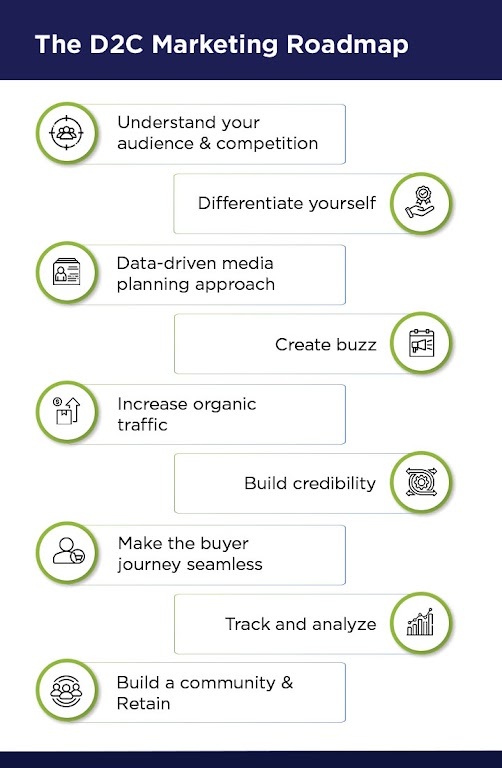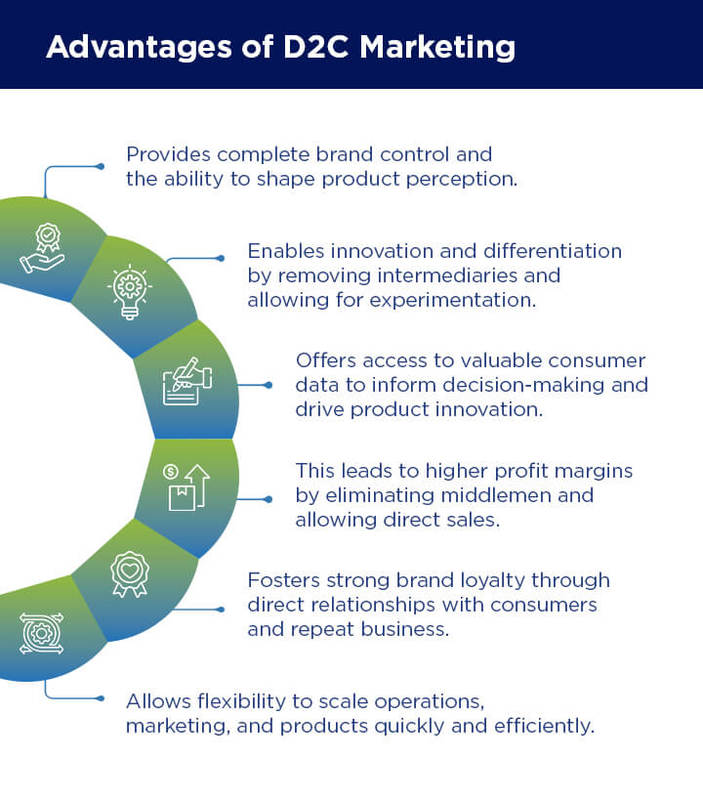The D2C market in India is growing rapidly, with an estimated market size of $100 billion by 2025, according to a recent report by Data Labs.
In recent years, more and more companies have bypassed traditional retail channels and selling directly to consumers through their websites, social media, and other digital platforms. This allows them to gather valuable customer data, personalise their marketing efforts, and better connect with their audience. The result is super fast growth.
D2C marketing, when done right, enables brands to proliferate. Boat, a consumer electronics brand, was the quickest D2C brand to reach INR 100 Cr in just two years. Another D2C fashion brand, Bewakoof, plans to reach Rs 2,000 crore in sales by 2025. With a focus on customer engagement and personalised experiences, these brands have become household favourites in just a few years.
What is D2C Marketing?
Direct-to-consumer (D2C) marketing refers to the practice of companies selling their products or services directly to consumers through their own channels without relying on traditional retailers or mediators.
D2C marketing is all about building a brand people love and trust. It involves using omnichannel marketing to reach out to a broader set of audiences. Customers are nurtured at every stage of the marketing funnel using marketing automation & personalised communication. Let’s look at the steps involved in creating a D2C marketing plan.
The D2C Marketing Roadmap

Understand your audience & competition
First things first. You can only connect with your audience if you understand them. So thoroughly research & understand your audience’s preferences, pain points, and buying behaviour. Then focus on understanding your competitors’ strengths and weaknesses.
Create your brand’s story
Based on your research, identify a unique value proposition that sets you apart from your competition. Now develop a story around your brand that resonates with your target audience. Your brand story should help position your brand in the market & it will be the basis of your entire brand messaging.
Focus on the best media channels
Develop a media plan that leverages a mix of paid, owned, and earned media to maximise your reach and engagement. Use data to identify the most effective channels to reach your target audience.
Create buzz
Develop campaigns that help generate excitement around your brand and encourage online sharing and word-of-mouth marketing. This may involve partnering with influencers or leveraging user-generated content, social media contests, and experiential marketing campaigns.
Build credibility
Establish your brand as a trusted and credible source of information by providing valuable content. Leverage social proof, such as customer reviews and testimonials. Furthermore, provide honest communication and establish your brand as a thought leader in your industry.
Increase organic traffic
Implement SEO best practices to improve your website’s visibility in search engine results pages (SERPs) and drive organic traffic. Consider leveraging long-tail keywords, creating high-quality content, and optimising your website for mobile devices. Additionally, focus on building high-quality backlinks from reputable websites in your industry.
Make the buyer’s journey seamless
Optimise your website’s user experience to make the buyer journey seamless and intuitive. This includes simplifying the checkout process, offering multiple payment options, and providing clear and concise product information. Use retargeting ads and email campaigns to keep customers engaged and encourage repeat purchases.
Analyse & optimise campaigns
To track and analyse your D2C marketing campaigns, you need to set up tracking across relevant channels and define your KPIs. Regularly analyse your results to understand your campaigns’ performance and make data-driven decisions to achieve your goals.
Build a community & retain customers
Create a post-purchase engagement strategy that keeps your customers engaged and interested in your brand. To engage and retain customers, focus on providing excellent customer service and leveraging loyalty programs and incentives. Consider using email and social media marketing campaigns to keep customers informed about new products and promotions.
Remember, a successful D2C marketing campaign is all about delighting the customer wherever they are in the buyer’s journey. You’ll be well-positioned to do just that by taking a funnel-wise approach. Let’s explore funnel-wise strategies that will help you ace your D2C marketing game.
Funnel-wise Strategies for D2C Marketing
1. TOFU (Top of funnel strategies)
Top-of-the-funnel (TOFU) strategies are marketing tactics designed to reach a broad audience and acquire potential customers. Here are some top-of-the-funnel strategies for D2C marketing:
- Content marketing to create awareness
Create and share valuable content, such as blog posts, videos, and social media posts, to attract and engage with potential customers.
- Email outreach
Build an email list of potential customers and reach out to them with relevant information about your product or service. Personalize your messages and include calls to action to encourage them to better engage with your brand.
- Influencer marketing
Partner with relevant influencers to expand the brand’s reach and build credibility.
- SEO
Consistently optimise your website and GMB listing content as per SEO best practices to increase search rankings & improve brand discoverability.
- PR and media outreach
Get your product & brand featured in popular media publications to build credibility.
- Events and activations
Host online & offline events or carry out activation events so that potential customers get to experience the brand’s products firsthand.
- Paid advertising
Use targeted paid advertising on relevant platforms to increase your brand’s visibility.
Real-life Example
At Amura, we enabled IVOOMi, an EV manufacturing company, to increase visibility, drive website traffic, and boost sales.
Prior challenges included a lack of digital brand awareness, no defined online journey, irregular postings, and no past digital sales. To tackle the same, we conducted market research, developed creative ad copies and visuals, used targeting options on Facebook, Instagram, and Google, and implemented retargeting ads. Furthermore, we regularly monitored and optimized the campaign to overcome the challenges.
The campaign achieved impressive results, including an ACOS of 0.7%, generating revenue through assisted conversions. It also boosted brand awareness and loyalty, with 50% more social media engagement and likes, and resulted in over 350 digital vehicle sales, meeting the primary objective of driving sales.
KPIs and Techstack for TOFU
| Strategy | KPIs | Tech-Stack |
|---|---|---|
| Content Marketing | Traffic, Page Views, Time on Page, Bounce Rate | Content Management System (CMS), Google Analytics, SEMRush |
| Paid Advertising | Impressions, Click-Through Rate (CTR) | Facebook Ads, Google Ads, LinkedIn Ads, Programmatic Ads |
| Email and WhatsApp Outreach | Open Rate, Click-Through Rate (CTR), Conversion Rate | Email Marketing Software (e.g., Mailchimp, Constant Contact), WhatsApp Business API |
| Influencer Marketing | Reach, Engagement Rate, Conversion Rate | Influencer Marketing Platform (e.g., AspireIQ, Grin), Google Analytics |
| SEO Marketing | Organic Traffic, Keyword Rankings, Backlinks | SEO Tools (e.g., Ahrefs, Moz), Google Analytics, Google Search Console |
| PR and Media Outreach | Impressions, Media Mentions | Google Analytics |
| Events and Activations | Attendance, Engagement Rate, Social Media Mentions | Social Media Monitoring Tools (e.g., Hootsuite, Sprout Social) |
2. MOFU (Middle-of-the-funnel strategies)
Middle-of-the-funnel (MOFU) strategies are marketing tactics designed to nurture potential customers who have already shown an interest in the brand. Here are some middle-of-the-funnel strategies for D2C marketing:
- Remarketing
Use customer reviews and testimonials to showcase the benefits of your product or service. This can be done through social media posts, retargeting ads, and website content.
- Free trials and demos
Offering free trials, or demos of the brand’s products can provide potential customers a risk-free way to try the products and see if they are a good fit.
- Interactive content
Quizzes, assessments, and calculators can be used to engage potential customers and provide personalized recommendations based on their needs and preferences.
- Nurturing potential customers
Develop a lead nurturing campaign to keep potential customers engaged and interested in your brand. This can include sharing personalised content via email, WhatsApp & SMS, offering exclusive content or promotions, and providing helpful resources or tips.
Real-life Example
Nisarga Herbs, an ayurvedic brand had less digital presence and no customer nurturing strategy in place. This resulted in a low returning customer rate of around 17%. We helped the brand implement a retention marketing strategy to improve their overall ROI of digital marketing campaigns.
We recommended setting up automated nurturing flows and automated transactional messages like abandoned cart flows and order notifications to support an increase in the conversion rate and make the customer experience more seamless.
Additionally, Amura created a sense of urgency through countdown timer sticky bars and pop-ups during limited time promotional periods. As a result, the conversion rate increased to 1.75%, returning customer rate increased to 23%, and monthly revenue grew by 185%. Between 10-15% of monthly revenue is now generated from nurturing activities.
KPIs and Techstack for MOFU
| Strategy | KPIs | Tech-Stack |
|---|---|---|
| Nurturing potential customers | Open Rate, Click-Through Rate (CTR), Conversion Rate | Email Marketing Software, Marketing Automation Tools |
| Remarketing | Customer Reviews, Testimonials, Click-Through Rate (CTR) | Customer Reviews Platform (e.g., Yotpo, Trustpilot), Ad Retargeting Platforms (e.g., AdRoll, Google Ads) |
| Free Trials and Demos | Conversion Rate, Retention Rate, Subscription Rate Feedback/Review Ratings | Customer Relationship Management (CRM) Software, User Feedback Platforms (e.g., UserTesting, Qualtrics) |
| Interactive content | Engagement Rate, Time on Page, Average Session Duration, Conversions | Interactive Content Platforms (e.g., Outgrow, Survey Anyplace), Google Analytics |
3. BOFU (Bottom-of-the-funnel strategies)
Bottom-of-the-funnel (BOFU) strategies are marketing tactics that are designed to convert potential customers into paying customers. Here are some bottom-of-the-funnel strategies for D2C marketing:
- Abandoned cart recovery
Abandoned cart communication can be an effective way to recover lost sales. Brands can look at offering a discount or other incentives to encourage customers to complete the purchase.
- Loyalty and referral programs
Loyalty and referral programs can be an effective way to incentivize repeat purchases and referrals.
- Remarketing
Offer limited-time offers and promotions to customers who have shown interest in your product but haven’t yet purchased it.
Real-life Example
At Amura, we assisted Kenstar – a consumer electronics brand – in implementing a remarketing strategy to address conversion challenges.
We executed a product-centric remarketing campaign, showcasing the features and usage of their products, aiming to connect with modern households. The results were impressive, with ten million+ impressions, three million+ reach, and 1 million website visits.
KPIs and Techstack for BOFU
| Strategy | KPIs | Tech-Stack |
|---|---|---|
| Abandoned cart recovery | Cart Recovery Rate, Conversion Rate, Customer Lifetime Value | Email Marketing Software, E-commerce Platforms (e.g., Shopify, Magento) |
| Remarketing | Click-Through Rate (CTR), Conversion Rate, Customer Acquisition Cost (CAC), ROAS (Return on Ad spent), AOV (Average Order Value) | Ad Retargeting Platforms (e.g., AdRoll, Google Ads), Customer Relationship Management (CRM) Software |
| Loyalty and Referral Programs | Repeat Purchase Rate, Referral Rate, Customer Lifetime Value | Loyalty and Referral Program Software (e.g., Smile.io, ReferralCandy), E-commerce Platforms |
Other Smart Techniques to Maximize Sales
- WhatsApp Business
By using WhatsApp Business, brands can communicate with customers in real-time, answer questions, and provide personalized support.
- WhatsApp Catalog
Brands can use WhatsApp catalogs to showcase their products and make it easier for customers to browse and purchase products directly through the app.
- Live Shopping
Live Shopping involves hosting live events where brands showcase their products and offer exclusive discounts to viewers.
- Instagram Catalog
Instagram Catalog allows brands to showcase their products on Instagram, making it easier for customers to browse and purchase products directly through the app.
- Push Notifications
By sending push notifications to customers’ devices, brands can remind customers about promotions, new products, and other relevant updates.
- Brand collaborations
Collaborating with other brands can expand your reach and tap into new audiences. By working together, D2C brands can create more engaging and memorable campaigns that resonate with their target audience.
Hyperlocal Marketing
Hyperlocal marketing is a type of marketing that focuses on a specific audience inside a specific geographical area. The strategy allows D2C brands to focus on a specific geographical area, like a city, neighborhood or even a specific street.
To connect with local consumers, brands can understand their specific needs and preferences and customize their messages and offers accordingly. Some of the tactics used in hyperlocal marketing include:
-
Improving search visibility with local SEO & GMB optimization
-
Targeting specific neighborhoods with social media ads
-
Offering local promotions with geo-targeted email campaigns
-
Building credibility with local influencers
-
Collaborating with those who have established trust with local consumers.
Advantages of D2C Marketing

-
Provides complete brand control and the ability to shape product perception.
-
Enables innovation and differentiation by removing intermediaries and allowing for experimentation.
-
Offers access to valuable consumer data to inform decision-making and drive product innovation.
-
This leads to higher profit margins by eliminating middlemen and allowing direct sales.
-
Fosters strong brand loyalty through direct relationships with consumers and repeat business.
-
Allows flexibility to scale operations, marketing, and products quickly and efficiently.
Bottom Line
Understanding the latest trends and best practices is important to stay ahead of the game. By following the strategies and tips outlined in this blog, you can stay on top of your game and achieve your marketing goals.
Partnering with a full-funnel digital marketing agency like Amura is another great option to launch your online store, scale your business, and kick-start continuous sales successfully. With innovative tech integrations and creative marketing solutions, we at Amura help businesses grow a community of loyal customers while increasing revenue.
FAQs
What is the difference between B2C and D2C?
B2C companies typically sell their products through retailers or wholesalers, who then sell them to consumers. In contrast, D2C companies sell their products or services directly to consumers, without the need for intermediaries. D2C companies typically use their online platforms, such as e-commerce websites, social media, or mobile apps, to reach and sell to their target customers.
Is Amazon a D2C?
Amazon can be considered both a B2C and a D2C company. While Amazon started as an online retailer selling products from other companies to consumers, it has since expanded its business model to include selling its own branded products directly to consumers. Amazon’s private label brands, such as Amazon Basics and Amazon Essentials, are examples of its D2C business model.
Is Zomato a D2C company?
Zomato is primarily a B2C company. It operates as an online platform that connects consumers with restaurants and food delivery services. Zomato does not sell its products or services directly to consumers but rather acts as an intermediary between consumers and its partner restaurants and delivery services.
What is the D2C business model?
The D2C business model involves selling products or services directly to consumers, without the need for intermediaries such as retailers or wholesalers. D2C companies typically use their own online platforms, such as e-commerce websites, social media, or mobile apps, to reach and sell to their target customers.
What is the difference between B2B and D2C?
B2B companies sell their products or services to other businesses rather than individual consumers. The sales process in B2B typically involves negotiations between company representatives, long sales cycles, and larger transactions. In contrast, D2C companies sell their products or services directly to consumers, bypassing intermediaries such as retailers or wholesalers. D2C companies use their online platforms, such as e-commerce websites, social media, or mobile apps, to reach and sell to their target customers.


